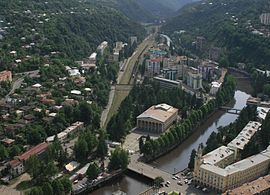Sestaponi – Satschchere railway line
| Sestaponi – Satschere | |||||||||||||||||||||||||||||||||||||||||||||||||||||||||||||||||||||||||||||||||||||||||
|---|---|---|---|---|---|---|---|---|---|---|---|---|---|---|---|---|---|---|---|---|---|---|---|---|---|---|---|---|---|---|---|---|---|---|---|---|---|---|---|---|---|---|---|---|---|---|---|---|---|---|---|---|---|---|---|---|---|---|---|---|---|---|---|---|---|---|---|---|---|---|---|---|---|---|---|---|---|---|---|---|---|---|---|---|---|---|---|---|---|
|
Chiatura station area
| |||||||||||||||||||||||||||||||||||||||||||||||||||||||||||||||||||||||||||||||||||||||||
| Route length: | 55 km | ||||||||||||||||||||||||||||||||||||||||||||||||||||||||||||||||||||||||||||||||||||||||
| Gauge : | 900 mm / 1520 mm | ||||||||||||||||||||||||||||||||||||||||||||||||||||||||||||||||||||||||||||||||||||||||
| Power system : | 3000 = | ||||||||||||||||||||||||||||||||||||||||||||||||||||||||||||||||||||||||||||||||||||||||
|
|||||||||||||||||||||||||||||||||||||||||||||||||||||||||||||||||||||||||||||||||||||||||
The Sestaponi – Satschchere railway in Georgia connects Satschchere and the Chicha mine with the country's main railway line, the Poti – Baku railway .
history
Narrow gauge railway
The railway line was initially built in several stages as a narrow-gauge railway with a gauge of 900 mm. The builders were German mining companies. These included the Oberhausen Gutehoffnungshütte , Friedrich Krupp AG , the Schalker Mine and Hüttenverein , the Gelsenkirchener Bergwerks-Aktien-Gesellschaft and the Hamburg Caucasian Mine Association .
At that time, Chiatura was the world's largest center of manganese ore mining . The share in world volume was almost 40%, the share in world exports was over 50%. From 1879 almost all mines were in the hands of German companies. The Schorapani – Chiatura section of the line went into operation in 1895. The section to Darkwedi followed in 1900 and in 1904 the continuation to Satschchere.
When the First World War broke out in 1914, all German property in Russia was confiscated as property of the enemy and the route was operated by the Transcaucasian Railway .
Broad gauge railway
The track was in 1957 Russian broad gauge umgespurt . It was then electrified with 3000 V direct current from 1957 to 1959 . In 1972, it was extended beyond Satschere to a mine in Tschicha. Only freight traffic takes place on this last section .
In passenger traffic there are two pairs of trains a day between Satschere and Kutaisi .
literature
- Neil Robinson: World Rail Atlas . Vol. 8: The Middle East and Caucasus . 2006. ISBN 954-12-0128-8 .
Web links
- Homepage of the Georgian Railway (en, ge, ru).
Remarks
- ↑ This corresponds to the information in the text part of the Robinson Railway Atlas. After the table section, plate 53, the route began in Sestaponi.


